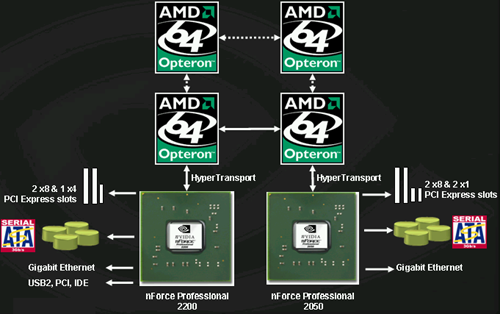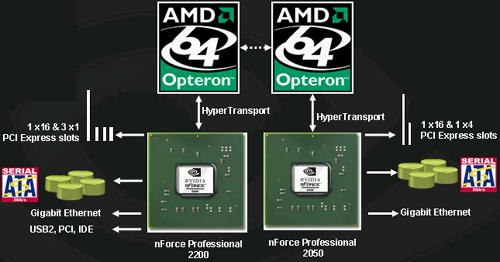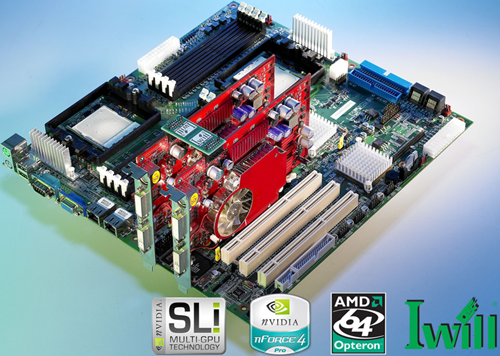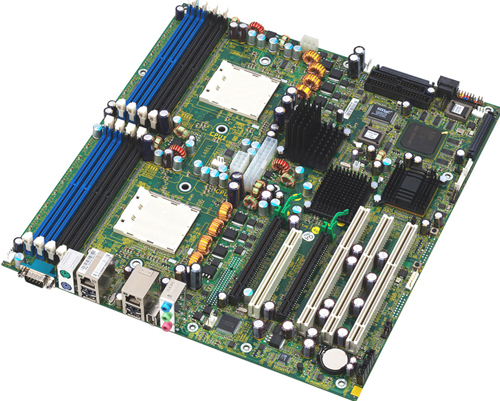NVIDIA nForce Professional Brings Huge I/O to Opteron
by Derek Wilson on January 24, 2005 9:00 AM EST- Posted in
- CPUs
The Kicker(s)
On server setups with available HyperTransport lanes to processors, up to 3 nForce Pro 2050 MCPs can be added alongside a 2200 MCP.
As each MCP makes a HT connection to a processor, a dual or quad processor setup is required for a server to take advantage of 3 2050 MCPs (in addition to the 2200), but in the case where such I/O power is needed, the processing power would be an obvious match. It is possible for a single Opteron to connect to one 2200 and 2 2050 MCPs for slightly less than the maximum I/O, as any available HyperTransport link can be used to connect to one of NVIDIA's MCPs. Certainly, the flexibility now offered by AMD and NVIDIA to third party vendors has been increased multiple orders of magnitude.
So, what does a maximum of 4 MCPs in one system get us? Here's the list:
- 80 PCI Express lanes across 16 physical connections
- 16 SATA 3Gb/s channels
- 4 GbE interfaces
Keep in mind that these features are all part of MCPs connected directly to physical processors with 1GHz HyperTransport connections. Other onboard solutions with massive I/O have provided multiple GbE, SATA, and PCIe lanes through a south bridge, or even the PCI bus. The potential for onboard scalability with zero performance hit is staggering. We wonder if spreading out all of this I/O across multiple HyperTransport connections and processors may even help to increase performance over the traditional AMD I/O topography.

Server configurations can drop an MCP off of each processor in an SMP system.
The fact that NVIDIA's RAID can span across all of the devices in the system (all 16 SATA 3Gb/s and the 4 PATA devices from the 2200) is quite interesting as well. Performance will be degraded by mixing PATA and SATA devices (as the system will have to wait longer on PATA drives), and likely, most will want to keep RAID limited to SATA. We are excited to see what kind of performance that we can get from this kind of system.
So, after everyone catches their breath from the initial "wow" factor of the maximum nForce Pro configuration, keep in mind that this will only be used in very high end servers using Infiniband connections, 10 GbE, and other huge I/O interfaces. Boards will be configured with multiple x8 and x4 PCIe slots. This will be a huge boon to the high end server market. We've already shown the scalability of the Opteron at the quad level to be significantly higher than Intel's Xeon (single front side bus limitations hurt large I/O), but unless Intel has some hidden card up their sleeve, this new boost will put AMD based high end servers well beyond the reach of anything that Intel could put out in the near term.
On the workstation side, NVIDIA will be pushing dual processor platforms with one 2200 and one 2050 MCP. This will allow the following:
- 40 PCI Express lanes across 8 physical connections
- 8 SATA 3Gb/s channels
- 2 GbE interfaces

This is the workstation layout for a DP NFPro system.
Again, it may be interesting to see if a vendor will come out with a single processor workstation board requiring an Opteron 2xx to enable a 2200 and 2050. This way, a single processor workstation could be had with all the advantages of the system.

IWill is shipping their DK8ES as we speak and should have availability soon.
While NVIDIA hasn't announced SLI versions of Quadro or support for them, boards based on the nForce Pro will support SLI version of Quadro when available. And the most attractive feature of the nFroce Pro when talking about SLI is this: 2 full x16 PCI Express slots. Not only do both physical x16 slots have all x16 electrical connections, but NVIDIA has enough headroom left for an x4 slot and some x1 slots as well. In fact, this feature is big enough to be a boon without the promise of SLI in the future. The nForce Pro offers full bandwidth and support for multiple PCI Express cards, meaning that multimonitor support on PCI Express just got a shot in the arm.
One thing that's been missing since the move away from PCI graphics cards has been multiple card support in systems. Due to the nature of AGP, running a PCI card alongside an AGP card is nice, but PCI cards are much lower performance. Finally, those who need multiple graphics cards will have a solution with support for more than one of the latest and greatest graphics cards. This means two 9MP monitors for some, and more than two monitors for others. And each graphics card has a full x16 connection back to the rest of the system.

Tyan motherboards based on nForce Pro are also shipping soon according to NVIDIA.
The two x16 connections will also become important for workstation and server applications that wish to take advantage of GPUs for scientific, engineering, or other vector-based applications that lend themselves to huge arrays of parallel floating point hardware. We've seen plenty of interest in doing everything from fluid flow analysis to audio editing on graphics cards. It's the large bi-directional bandwidth of PCI Express that enables this, and now that we'll have two PCI Express graphics cards with full bandwidth, workstations have even more potential.
Again, workstations will be able to have RAID across all 8 SATA devices and 4 PATA devices if desired. We can expect mid-range and lower end workstation solutions only to have a single nForce 2200 MCP on them. NVIDIA sees only the very high end of the market looking at pairing the 2200 with 2050 in the workstation space.
Perhaps the only down side to the huge number of potential PCI Express lanes available is the inability of NVIDIA MCPs to share lanes between MCPs and slight lack of physical PCI Express connections. In otherwords, it will not be possible to have a motherboard with 5 x16 PCI Express slots or 10 x8 PCI Express slots, even though there are 80 lanes available. Of course, having 4 x16 slots is nothing to sneeze at. On the flip side, it's not possible to put 1 x16, 2 x4, and 6 x1 PCIe slots on a dual processor workstation. Even though there are a good 16 PCI Express lanes available, there are no more physical connections to be had. Again, this is an extreme example, and not likely to be a real world problem. But it's worth noting nonetheless.










55 Comments
View All Comments
ProviaFan - Monday, January 24, 2005 - link
For a long time, making a quad CPU workstation was pretty much not an option, because there was no way to connect an AGP graphics card for good 3D performance (yes, there is a PCI-X Parhelia, and no, that doesn't count). The only one I can remember was an SGI desktop system with 4 PIII's, though maybe the graphics on that were integrated (though of course they weren't bad, unlike Intel's).Now, with a quad CPU system and PCI-E, it will be possible to do whatever you want with those x16 slots, including using a high-performance graphics card (or two, which is something that used to be reserved for Sun systems with their proprietary graphics connectors). Or, with dual core, you could have a virtually 8-way workstation, though I'm not sure what the benefit of that would be outside of complex scientific calculations or 3D rendering.
The sad part is there's no freakin way that I'll be able to afford that... :(
jmautz - Monday, January 24, 2005 - link
I may have missed it, but I didn't see anything about support for dual-core processors. Was this mentioned? I would love to get a dual-core dual Opt board with all PCIe slots (2x16, 1x4, 4x1 would be nice).R3MF - Monday, January 24, 2005 - link
update on the Abit DualCPU board:Chipset
* nVidia CrushK8-04 Pro Chipset
> it does appear to use the nForce4 chipset, so one immediate question springs to mind: why if they can get numa memory on dual CPU boards with the nForce4, can they not do the same with the nForce Pro?
R3MF - Monday, January 24, 2005 - link
what does this mean for the new Abit DualCPU board:http://forums.2cpu.com/showthread.php?s=ef43ac4b9b...
one core-logic chip, yet with NUMA memory, presumably this means it is not an nForce Pro board if i understand anandtechs diagrams correctly.....?
i like the sound of the Abit board:
2x CPU
2x NUMA memory per CPU
2x SLI
4x SATA2 slots
1x GigE with Active Armour (my guess)
best of all i am not paying for stuff i will never use like:
second GigE socket
PCI-X
registered memory
the only thing it lacks is a decent sound solution, but then every nForce4 suffers the same lack. hopefully someone will come out with a decent PCI-E dolby-digital soundcard...............
R3MF - Monday, January 24, 2005 - link
@ 10 - i don't think so. the active armour is a DSP that does the necessary computations to run the firewall, as opposed to letting the CPU do the grunt work.Illissius - Monday, January 24, 2005 - link
Isn't the TCP offload engine thingy just ActiveArmor with a different name?R3MF - Monday, January 24, 2005 - link
two comments:the age of cheap dual opteron speed demons is not yet up on us, because although you only need one 2200 chip to have a dual CPU rig the second CPU connects via the first, thus you only get 6.4GB bandwidth as opposed to 12.8GB. yes you can pair a 2200 and a 2050 together but i bet they will be very pricey!
the article makes mention of SLI for quaddro cards, presumably driver specific to accomodate data sharing over two different PCI-E bridges as opposed to one PCI-E bridge as is the case with nForce4 SLI. this would seem to indicate that regular PCI-E 6xxx series cards will not be able to be used in an SLI confiuration on nForce Pro boards as the ability will not be enabled in the driver. am i right?
DerekWilson - Monday, January 24, 2005 - link
The Intel way of doing PCI Express devices is MUCH simpler. 3 dedicated x8 PCI Express ports on their MCH. These can be split in half and treated as two logical x4 connections or combined into a x16 PEG port. This is easy to approach from a design and implimentation perspective.Aside from NVIDIA having a more complex crossbar that needs to be setup at boot by the bios, allowing 20 devices would meant NVIDIA would potentially have to setup and stream data to 20 different PCI Express devices rather than 4 ... I'm not well versed in the issues of PCI Express, or NVIDIA's internal architecture, but this could pose a problem.
There is also absolutely no reason (or physical spec) to have 20 x1 PCI Express lanes on a motherboard ;-)
I could see an argument to have 5 physcial connections in case someone there was a client that simply needed 5 x4 connections. But that's as far as I would go with it.
The only big limitation is that the controllers can't span MCPs :-)
meaning it is NOT possible to have 5 x16 PCI Express connectors a quad Opteron mobo with the 2200 and 3 2050s. Nor is it possible to have 10 x8 slots. Max bandwidth config would be 8 x8 slots and 4 x4 slots ... or maybe throw in 2 x16, 4 x8, 4 x4 ... Thats still too many connectors for conventional boards ... I think I'll add this note to the article.
#7 ... There shouldn't be much reason for MCPs to communicate explicityly with eachother. It was probably necessary for NVIDIA to extend the RAID logic to allow it to span across multiple MCPs, and it is possible that some glue logic may have been neccessary to allow a boot device to be locate on a 2050 for instance. I can't see it being 2M transistors in MCP-to-MCP kind of stuff though.
ksherman - Monday, January 24, 2005 - link
I agree with #6... I think the extra transistors would be used to allow all the chips to communicate.mickyb - Monday, January 24, 2005 - link
One has to wonder what the 2 million extra transisters are for. I would be surprised if it was "just" to allow multiple MCPs. Sounds like a lot of logic. I am also surprised about the 4 physical connector limit. I didn't realize the PCI-e lanes had to partitioned off like so. I assumed that if there were 20 lanes, they could create up to 20 connectors.